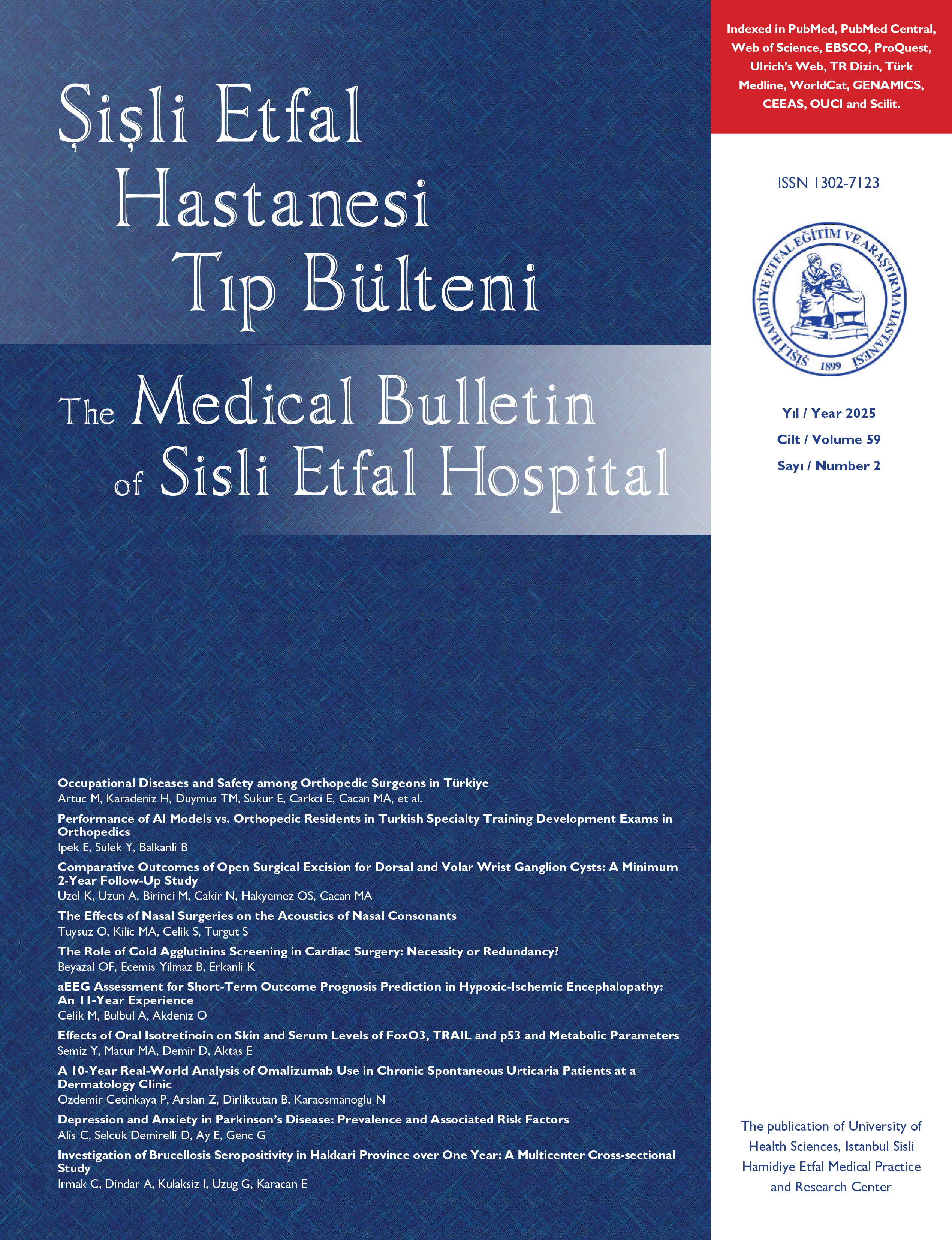
Pandeminin Kedi ve Köpek Alerjisine Etkisi
Guler Yildirim1, Begum Nalcakan Gunes2, Nilay Caliskan1, Hamit Bologur1, Hilal Gungor1, Muhammed Fatih Erbay1, Merve Karaca Sahin1, Ozlem Terzi3, Deniz Ozceker11Prof. Dr. Cemil Taşçıoğlu Şehir Hastanesi, Pediatrik Alerji ve İmmünoloji Kliniği, İstanbul2Sultanbeyli Devlet Hastanesi, Çocuk Sağlığı ve Hastalıkları Kliniği, İstanbul
319 Mayıs Üniversitesi, Halk Sağlığı Anabilim Dalı, Samsun
Amaç: Koronavirüs hastalığı (COVID-19) pandemisinin alerjik hastalar üzerine etkisi net olarak anlaşılamamıştır. Bu çalışmanın amacı, İstanbulda solunum yolu alerjisi olan hastalarda, COVID-19 pandemisinin, kedi ve köpek alerjen duyarlılığı üzerindeki değişiklikleri araştırmaktır.
Yöntem: Pandemi öncesi (2018 mart-2020 mart) ve pandemi dönemi ve sonrası (2020 mart-2022 mart) deri testi uygulanan total 5499 hasta retrospektif olarak değerlendirildi. Hastaların yaş, cinsiyet, tanı, total IgE ve eozinofil değerleri kaydedildi. Hastalar 2-6 yaş, 7 yaş ve üstü olmak üzere iki gruba alındı. Her iki grupta pandemi öncesi ve sonrası kedi ve köpek duyarlanma sıklığını araştırıldı.
Bulgular: Çalışmaya dahil edilen 5499 çocuğun ortanca yaşı 77 aydı ve aralığı 2 ile 221 ay arasındaydı. Ayrıca, çocukların %55,7'si erkekti. Çocukların %59,1i pandemi öncesi ve %40,9u pandemi ve sonrası dönemde muayene edilmişti. Muayenelerde 1628 (%29,6) çocukta alerjik rinit, 1829 (%33,3) çocukta astım ve 2042 (%37,1) çocukta hem astım hem de alerjik rinit olduğu belirlendi. Çocukların 247sinde (%4,5) kediye karşı, 166sında (%3,0) köpeğe karşı alerji olduğu tespit edildi. Yaş gruplarını kendi içinde, pandemi öncesi ile pandemi döneminde kedi alerjisi görülme sıklığı açısından karşılaştırıldığında 7 yaş ve üstü grubunda duyarlılığın pandemi öncesine göre düşmüş olduğu ve istatistiksel farkın anlamlılığa oldukça yakın olduğu belirlendi (p=0,08). Ancak köpek alerjisi açısından, 7 yaş ve üstü grubunda pandemi öncesi %5,6 olan köpek duyarlılığı pandemi döneminde %2,6ya düşmüştü ve bu düşüş istatistiksel düzeyde çok anlamlı bulundu (p<0,001).
Sonuç: Çevresel alerjen maruziyetin alerjik hastalıkların fenotipi üzerinde önemli etkisi vardır. Salgın günlerinde hastaların yaşam tarzı değişiklikleri ve evde geçen sürenin artması, dış ortamdaki kedi ve köpek alerjenleriyle temasın azalması kedi ve köpek duyarlılığı sıklığının azalmasına neden olmuş olabilir. Ayrıca pandemiyle birlikte hayatımıza giren maske-mesafe- el yıkama /dezenfektan kurallarının da kedi ve köpek alerjenleriyle teması azalttığı ve buna bağlı alerji sıklığının azalmış olabileceği düşünüldü. (SETB-2023-12-229)
Anahtar Kelimeler: Alerji, kedi alerjisi, çocukluk çağı, köpek alerjisi, pandemi
The Impact of the Pandemic on Cat and Dog Allergies
Guler Yildirim1, Begum Nalcakan Gunes2, Nilay Caliskan1, Hamit Bologur1, Hilal Gungor1, Muhammed Fatih Erbay1, Merve Karaca Sahin1, Ozlem Terzi3, Deniz Ozceker11Department of Pediatric Allergy and Immunology, Prof. Dr. Cemil Tascioglu City Hospital, Istanbul, Türkiye2Department of Pediatrics, Sultanbeyli State Hospital, Istanbul, Türkiye
3Department of Public Health, 19 Mayis University, Samsun, Türkiye
Objectives: The impact of the COVID-19 pandemic on allergic patients is not clearly understood. The aim of this study is to investigate the changes in sensitivity to cat and dog allergens in patients with respiratory allergies in Istanbul during the COVID-19 pandemic. Methods: Before the pandemic (March 2018 - March 2020) and during and after the pandemic (March 2020 - March 2022), a total of 5499 patients who underwent skin testing were retrospectively evaluated. The patients' age, gender, diagnosis, total IgE, and eosinophil values were recorded. Patients were divided into two groups: 2-6 years old and 7 years and older. The frequency of sensitization to cats and dogs was investigated in both groups before and after the pandemic.
Results: The median age of the 5499 children included in the study was 77 months, with a range of 2 to 221 months. Furthermore, 55.7% of the children were male. Of the children, 59.1% were examined before the pandemic, and 40.9% during and after the pandemic. During the examinations, allergic rhinitis was identified in 1628 children (29.6%), asthma in 1829 children (33.3%), and both asthma and allergic rhinitis in 2042 children (37.1%). Allergies to cats were found in 247 children (4.5%), and to dogs in 166 children (3.0%). When comparing the age groups, the frequency of cat allergy in the 7-years and older group was found to have decreased compared to the pre-pandemic period, and the statistical difference was close to significance (p=0.08). However, regarding dog allergy, in the 7 years and older group, the sensitivity to dogs, which was 5.6% before the pandemic, had decreased to 2.6% during the pandemic, and this decrease was found to be statistically highly significant (p<0.001).
Conclusion: Environmental allergen exposure has a significant impact on the phenotype of allergic diseases. Changes in patients' lifestyles and increased time spent at home during the pandemic may have led to a decrease in contact with outdoor cat and dog allergens, resulting in a reduced frequency of cat and dog sensitivity. Additionally, the introduction of mask-distance-handwashing/disinfection rules during the pandemic is believed to have reduced contact with cat and dog allergens, potentially contributing to a decrease in allergy frequency.
Keywords: Allergy, cat allergy, childhood, dog allergy, pandemic
Makale Dili: İngilizce



















